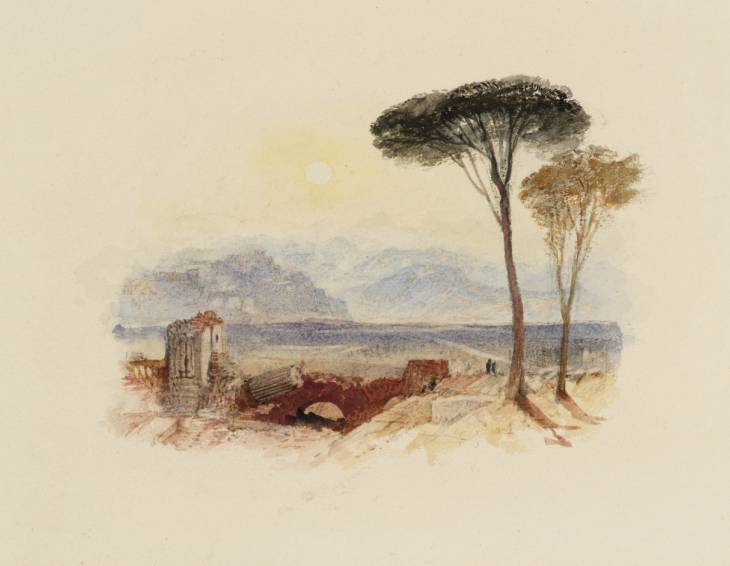Joseph Mallord William Turner Perugia, for Rogers's 'Italy' c.1826-7
Joseph Mallord William Turner,
Perugia, for Rogers's 'Italy'
c.1826-7
Joseph Mallord William Turner 1775–1851
Perugia, for Rogers’s ‘Italy’ circa 1826–7
D27661
Turner Bequest CCLXXX 144
Turner Bequest CCLXXX 144
Gouache, pencil and watercolour, approximately 110 x 158 mm on white wove paper, 234 x 307 mm
Stamped in black ‘CCLXXX 144’ bottom right
Stamped in black ‘CCLXXX 144’ bottom right
Accepted by the nation as part of the Turner Bequest 1856
Exhibition history
1904
National Gallery, London, various dates to at least 1904 (202).
1998
J.M.W. Turner: “That Greatest of Landscape Painters”: Watercolors from London Museums, Philbrook Museum of Art, Tulsa, February–April 1998 (27).
References
1903
E.T. Cook and Alexander Wedderburn (eds.), Library Edition: The Works of John Ruskin: Volume I: Early Prose Writings 1834–1843, London 1903, pp.233, 244.
1904
E.T. Cook and Alexander Wedderburn (eds.), Library Edition: The Works of John Ruskin: Volume XIII: Turner: The Harbours of England; Catalogues and Notes, London 1904, pp.380–1.
1906
E.T. Cook and Alexander Wedderburn (eds.), Library Edition: The Works of John Ruskin: Volume XXI: The Ruskin Art Collection at Oxford, London 1906, p.214, as ‘Nameless composition with stone pines’.
1909
A.J. Finberg, A Complete Inventory of the Drawings in the Turner Bequest, London 1909, vol.II, p.899, as ‘Italian composition’.
1979
Andrew Wilton, The Life and Work of J.M.W. Turner, Fribourg 1979, p.439 no.1170, reproduced.
1983
Cecilia Powell, ‘Turner’s vignettes and the making of Rogers’s “Italy” ’, Turner Studies, vol.3, no.1, Summer 1983, pp.8, 10.
1984
Cecilia Powell, ‘Turner on Classic Ground: His Visits to Central and Southern Italy and Related Paintings and Drawings’, unpublished Ph.D thesis, Courtauld Institute of Art, University of London 1984, pp.288, 292, 520 notes 68 and 80.
1993
Jan Piggott, Turner’s Vignettes, exhibition catalogue, Tate Gallery, London 1993, p.96.
1998
Richard P. Townsend, Andrew Wilton, David Blayney Brown and others, J.M.W. Turner: “That Greatest of Landscape Painters”: Watercolors from London Museums, exhibition catalogue, Philbrook Museum of Art, Tulsa 1998, no.27, pp.126–7, p.8 reproduced (colour).
2007
Ian Warrell (ed.), Franklin Kelly and others, J.M.W. Turner, exhibition catalogue, National Gallery of Art, Washington 2007, p.146, reproduced fig.30 (colour).
This vignette appeared as the end-piece to the thirty-fifth section of Rogers’s Italy, entitled ‘The Fire-fly’.1 It was engraved by Edward Goodall, who was one of the most prolific and skilled interpreters of Turner’s designs.2 Perugia offers an idealised view of the Umbrian plain, with the Apennines rising in the distance and scattered ancient ruins and umbrella or stone pines occupying an otherwise barren foreground.
Compared to many of his other Italian subjects, Turner had very little first-hand material to refer to while preparing this vignette. Although he did visit Perugia in 1819, he appears to have produced only two views of the city at this time (see Tate D16580, D16581; Turner Bequest CXCI 57a, 58). The vignette does not appear to have been modelled directly after either sketch, although the second drawing, which shows the city from a distance, may bear some relation. Instead, the content and composition of Perugia appear to have derived primarily from Turner’s memory and imagination, which would account for the confusion that has surrounded the title of the work. Although it was published in 1830 with the title Perugia, later writers were unable to recognise the subject matter: Ruskin called it a ‘nameless composition with stone pines’,3 whilst Finberg simply named it ‘Italian Composition.’4
Neither Perugia nor Tivoli, the vignette that appears as the head-piece to ‘The Fire-Fly’, bears any direct relationship to the topics discussed in this section of Italy. However, both compositions fuse the natural beauty of the Roman countryside with picturesque ancient ruins, expressing Rogers’s quintessential vision of Italy as the once glorious centre of Western civilisation.
Verso:
Inscribed by unknown hands in pencil ‘19’ and ‘1 b’ centre and ‘CCLXXX.144’ bottom centre and ‘D.27661’ bottom left. There is also a stroke of black watercolour bottom right
Stamped in black ‘CCLXXX 144’ bottom right.
Stamped in black ‘CCLXXX 144’ bottom right.
Meredith Gamer
August 2006
How to cite
Meredith Gamer, ‘Perugia, for Rogers’s ‘Italy’ c.1826–7 by Joseph Mallord William Turner’, catalogue entry, August 2006, in David Blayney Brown (ed.), J.M.W. Turner: Sketchbooks, Drawings and Watercolours, Tate Research Publication, December 2012, https://www

